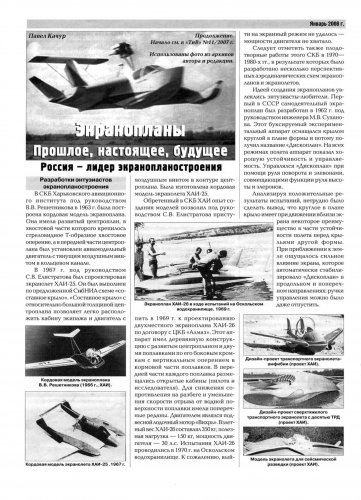Maveric
Fight for yor Right!
- Joined
- 14 January 2007
- Messages
- 2,227
- Reaction score
- 851
KhAI-17. The first post-war flying aircraft Kharkiv aviation institute became HAI-17. In 1957 a group of students, which decided on its own to design and build a small sports plane, organized the club, which led VV Reshetnikov. In work on the draft aircraft provided assistance to students associate professor L. Arson. Chief Designer O.K. Antonov supported enthusiasts. The company, which he guided, highlighted the production area, where the aircraft was built and HAI-17 (Fig. 317).
KhAI-17 - single cantilever nizkoplan. Motorcycle engine F-61K capacity of 30 hp (22 kW) located outside the cab driver and was fitted with a screw air chetyrehlopastnym variable step. The waste part of the fuselage beam construction. Chassis three.
In spring 1959, HAI-17 was raised in the air VV Reshetnikov. The tests showed that with the mass flight 352 148 2300 m.
The work of students going tradition 1930 - ies. Proved very necessary. The Council instructed the Institute associate professor PV Dybskomu organize HAI Student Design Bureau (SDB). Under the leadership of V. Reshetnikova - the first chief and chief designer SKB - were designed "Regulations" and "Charter" SKB HAI. In May 1959, the first in Ukraine SKB began its work. Ten students, participants in the design and construction of an aircraft HAI-17, received the Medal for the best scientific work student USSR. "
KhAI-18. In 1960, under the leadership of V. Reshetnikova in SKB HAI was started designing a double training aircraft HAI-18. Outwardly HAI-18 resemblance to its predecessor HAI-17. This cantilever with a low-wing monoplane large extent, pushing propeller and tricycle landing gear. Base material - wood. Places student and instructor stationed on each other. Managing double. It was assumed that with the motor cycle engine power of 50 hp (36.8 kW) HAI-18 will be the speed of 210 km / h ceiling 4250 metres and the mass flight of about 500 kg.
In 1962, a detailed project designed HAI-18 was handed over to one of aviazavodov, but has not been built.
In the work on the project, students participated Gaydachuk V., A. Kurilin, V. Leibow, S. Reshetnikova, L. Starikov, etc. They also began to manufacture aircraft at the aircraft, but due to lack of engine, it was decided to redesign existing aircraft under M-332 engine.
KhAI-19 - the second plane, built in the SKB (Figure 318). Designing and building it had been implemented for three months in 1961, Chief Designer - Head SKB VV Reshetnikov. We students have participated B. Zaslavsky, Gotenkov S., A. Sazonkin, V. Lyushnin, S. Reshetnikova, etc. The first test flight at HAI-19 fulfilled VV Reshetnikov.
After several successful flights in 1962-1963 he was. aircraft shown at the Exhibition of excellence Ukrainian SSR.
KhAI-19 - single cantilever nizkoplan tselno-wood construction. With its construction aggregates used crashed HAI-17.
Truss fuselage with a rounded upper fairing. Wing - odnolonzheronnoe with plywood boots - zakrylkami equipped with a slot type. Sheathing wing linen. Motorcycle engine M-16K equipped with a pressure regulator and an air chetyrehlopastnym propeller. Chassis managed to bow three-wheel. Track chassis 1.2 m base - 1.7 m.
KhAI-20 - next work SKB HAI. The aircraft was designed in 1963 Major designers and managers work - VP Lyushnin and VV Reshetnikov. Above the creation of aircraft operated Gaydachuk V., A. Gontar, A. Olefer, L. Starikov, G. Chub, A. Pilnyak, S. Reshetnikova, etc.
Based HAI-20 aircraft (Figure 319) was taken as a double draft HAI-18, which was redesigned in single engine F-332.
KhAI-20 - cantilever with a low-wing monoplane, pushing propeller and tricycle nose landing gear. The basic material - wood, used as plastic and metal.
Semi-fuselage design. In the front part - the pilot's cabin with removable lantern. And center fuselage is a single entity.
A wing consists of a trapezoidal shape and center consoles. Removable odnolonzheronnoy console design with a torque working styles and polotnyanoy plywood sheathing. These constructions are the same for the tail of feathers and all steering surface. Dvuhlonzheronny center, fully painted plywood. Flap gap located at the center and consoles. Ailerons with aerodynamic compensation.
The aircraft installed aviation engine M-332 (CSSR), chetyrehtsilindrovy, cylinder, air-cooled, 140 hp maximum power (103 kW). Engine secured to the fuselage in the vicinity of the carcass center. Vint pushing, the metal changed step, the reverse.
The Office of mixed aircraft. Rucka management and pedals are connected with the steering traction surfaces and cables. Office zakrylkami wire. Pedals through three additional traction and turning associated with the nasal backbone chassis.
In autumn 1967, HAI-20 has a cycle factory tests. The first plane lifted into the air, one of its founders G. Chub. The test flight took place at an altitude of up to 300 metres, confirmed the estimates. Overall raid on the HAI-20 was 15 h.
...thanks again Stingray, great work...
Do you have a complete designation list from the Charkov Institute, I believe the ChAI.35 was the last?
If you can please post a pic or drawing from the ChAI.18 ;D
Thanks a lot
Servus Maveric









































